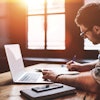The quest involved in Integrating the Healthcare Enterprise (IHE) is not so different from the daunting mission that consumes the characters in J.R.R. Tolkien’s Lord of the Rings trilogy. Both involve a long journey by a hardy band of individuals, tasked with the near-impossible. The partnerships seem unlikely, and yet, in both cases, the teams ultimately prevail. Finally, as was the case in Tolkien’s tale, what would seem journey’s end for the five-year IHE is turning out to be another new beginning.
Far from closing the book on its pursuit of true interoperability among information systems in radiology and elsewhere, the IHE is starting a new chapter: quantifying user benefits, expanding the IHE user base, and, indirectly, driving development of commercially available products that incorporate the tenets of integration.
The IHE’s sponsors, the Radiological Society of North America and the Healthcare Information Management and Systems Society (HIMSS), will divvy up duties as the initiative moves into its next phase. The RSNA will continue to spearhead IHE radiology initiatives, while HIMSS leads the effort to implement a broader IT foundation to support other clinical specialties, cardiology among them.
Established in 1999, the IHE first tackled integration of radiology imaging and information systems, with a five-year goal of compliance by all PACS, RIS, and HIS products.
Today, about 90% of the industry’s vendors are active participants in integration committees, demonstrations, and workshops, said Christopher Carr, director of informatics for the RSNA of Oak Brook, IL.
But while these vendors realize a range of technical and marketing benefits from that participation, relatively few have gone the extra step of providing off-the-shelf products that are IHE-compatible, he said.
The impetus for doing so must come from the user community, and it is this area that IHE's radiology leadership is focusing on in 2003.
"Our focus within radiology this year is achieving adoption by institutions," Carr said. "We’ve had some success in getting vendors to develop products based on the IHE model, but it’s following through and making that universal that is the real challenge now. As users become more involved, they will drive vendor product development."
To that end, at the 2002 RSNA meeting, the IHE eschewed traditional vendor demos in lieu of showcasing real-world applications and success stories by early adopters.
The resulting attendee feedback is shaping the organizations’ agenda. Purchasing decision-makers want more useful information about IHE-related products, Carr said. That information is now available on the RSNA’s IHE Web site, provided by eight vendors with commercial products tailored to integration specs.
The integration statements relate to the IHE Technical Framework, which is the core of the IHE. The framework comprises 10 integration "profiles" that provide precise definitions of how standards should be implemented to meet specific clinical needs for information distribution.
In late April, four new integration profiles were added at an annual workshop held for IHE radiology participants, a harbinger of the annual RSNA meeting in November.
While existing profiles served to close the communications loop between patient registration, image ordering, and acquisition, the new guidelines address workflow issues in reporting, post-processing, evidence documents, and access to radiology information from different archives.
Specifically, the profiles extend the DICOM modality worklist concept to the reporting and image post-processing steps, addressing storage transactions, and status verification, among others.
"The workflow profiles broaden the range of integration topics to address the whole diagnostic process," Carr said. "They represent a significant extension of IHE capabilities."
As in past years, the profiles will be put to the test at the 2003 RSNA meeting, where 40 vendors are expected to participate in IHE demonstrations, Carr said.
With the rollout of IHE within radiology well underway, the organization is now turning its attention to expansion within the broader world of information technology as well as other clinical applications.
Both HIMSS and the RSNA originally committed to a five-year sponsorship of the IHE effort. Despite being in the last year of that commitment, the endpoint is not yet at hand, Carr said.
"At some point, we’ll be satisfied with the progress made in radiology, and can relax the expansions of the technical framework," he said. "But there is still much to be done. We’ll maintain our sponsorship for the foreseeable future."
In the near term, IHE radiology is actively soliciting user success stories from radiologists and administrators. And it is sponsoring a seminar at the Symposium for Computer Applications in Radiology meeting in June on workflow integration.
Meanwhile, HIMSS is devising a strategy for IHE deployment within the larger world of healthcare information technologies. Like the RSNA, the organization is focusing on increased involvement by users, said Joyce Sensmeier, director of professional services at HIMSS, which is based in Chicago.
"Since the IT piece is really the horizontal development of IHE, it’s going to support not just radiology but all the other clinical areas," Sensmeier said. "Chief information officers are a critical audience for the IT piece, and now that it is hitting them beyond the radiology department, I think that will get them engaged."
The IHE has an ambitious goal to develop and approve four integration profiles to support an IT infrastructure by this August.
These profiles relate to implementation of patient identity cross-referencing across multiple registration domains; clinical query and report display; patient-synchronized applications; and advanced security and user authentication.
As IHE radiology has done in the past, the IT community will hold a vendor "connectathon" testing the various profiles in January 2004. A month later, IHE IT will participate in a joint demonstration showcasing ways HL7 standards are being implemented by the IHE. The latter will be a critical event, Sensmeier said.
"We rely on standards organizations like HL7 to provide the basis for interoperability, but IHE is taking it to the next step by providing implementation guidelines for their work," Sensmeier said.
The IHE has also forged a critical partnership that will take it beyond the realm of radiology. The American College of Cardiology (ACC) has signed on to sponsor the development of a technical integration framework within that specialty.
"It’s significant that we have a commitment from the ACC to grow that vertically," Sensmeier said. "And because we have a successful model based on radiology, they will benefit from that. We won’t have to reinvent the wheel."
Establishing a framework that could be used across the enterprise has always been the goal of the IHE -- and the RSNA, Carr said.
"What we had hoped all along would happen -- that the IHE would be adopted by other disciplines across the enterprise -- is starting to happen," he said. "Radiology was well-placed to do this. It’s exciting to forge the connections that have always seemed logical and necessary but have not been made before."
By Deborah R. Dakins
AuntMinnie.com contributing writer
May 12, 2003
Related Reading
IHE eyes real-world applications at RSNA, plans new IT committees, December 1, 2002
IHE expands into new domains in Year 4, April 3, 2002
IHE boosts systems integration prospects, January 30, 2002
IHE to consolidate early activities in Year 3, November 25, 2001
IHE looks for more participation by HIS vendors, other specialties, February 6, 2001
Copyright © 2003 AuntMinnie.com



















